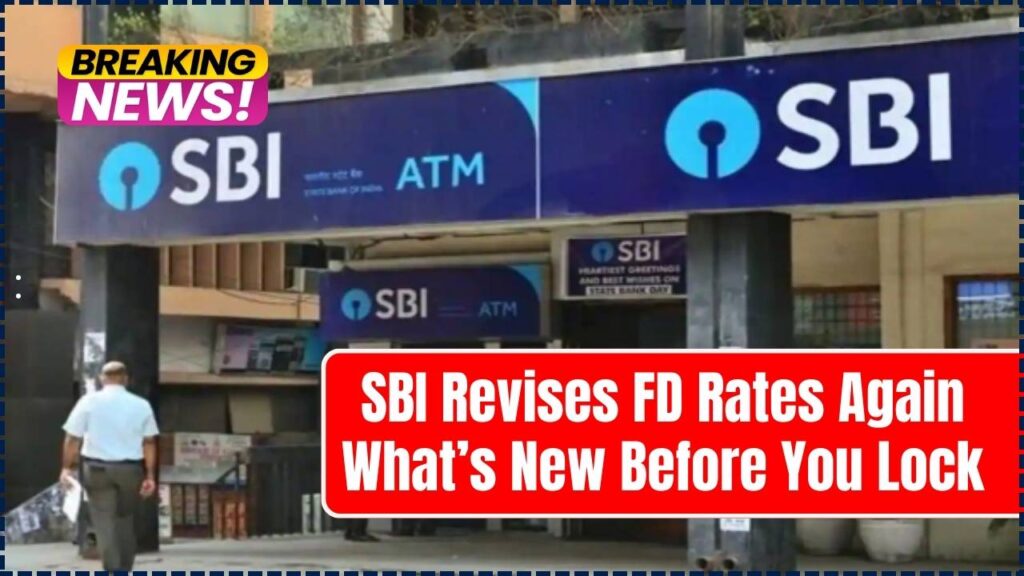SBI Revises FD Rates Again: The SBI revises FD rates again, and this latest revision brings important updates that every investor—from seasoned retirees to first-time savers—should understand before locking in their money. As of May 16, 2025, the State Bank of India (SBI) has implemented a reduction of 20 basis points (bps) across a range of Fixed Deposit (FD) tenures. This change impacts both general depositors and senior citizens, especially those who rely on FDs for stable, low-risk returns. The revision is closely tied to the broader monetary policy environment and recent moves by the Reserve Bank of India (RBI).

FDs remain a favored investment instrument for millions of Indian families, retirees, and conservative investors. They provide capital protection and predictable interest income, making them ideal for short- and long-term financial goals. Understanding the revised interest rate structure, special deposit schemes like Amrit Vrishti and SBI We-care, and alternative strategies can help you make smarter decisions with your hard-earned savings.
SBI Revises FD Rates Again
| Feature | Details |
|---|---|
| Effective Date | May 16, 2025 |
| Rate Cut | 20 basis points across most tenures |
| General Public FD Rates | 3.30% to 6.70% |
| Senior Citizen FD Rates | 3.80% to 7.30% |
| Special Scheme | ‘Amrit Vrishti’ – 6.85% (General), 7.35% (Senior Citizens) |
| Highest Rate Available | 7.35% for 444 days (Senior Citizens) |
| Source | SBI Official Site |
SBI’s latest FD rate revision is part of a wider economic strategy aimed at promoting growth. For investors, especially conservative savers, FDs still offer security, simplicity, and consistent income. The key is to choose the right product, tenure, and strategy. Special options like Amrit Vrishti and SBI We-care provide higher returns and should not be overlooked.
Why Did SBI Cut FD Rates?
This reduction in FD rates is part of a broader economic adjustment. In April 2025, the Reserve Bank of India cut the repo rate, the rate at which it lends to commercial banks. This decision was aimed at reviving consumer demand and investment, both of which had slowed amid global economic uncertainty and domestic inflation stabilization.
As interest rates in the broader economy shift, banks must follow suit to balance their cost of funds, profitability, and lending competitiveness. By lowering FD rates, banks reduce the interest they owe to depositors, thus freeing up more capital for lending at potentially lower rates.
Financial analysts have noted that while these cuts might affect savers in the short term, they align with the goal of economic stimulation, which could have broader positive effects in the long run.
SBI Revises FD Rates Again (Effective May 2025)
Here is the current FD rate chart for deposits below ₹3 crore:
| Tenure | General Public | Senior Citizens |
|---|---|---|
| 7 to 45 days | 3.30% | 3.80% |
| 46 to 179 days | 5.30% | 5.80% |
| 180 to 210 days | 6.05% | 6.55% |
| 211 days to <1 year | 6.30% | 6.80% |
| 1 to <2 years | 6.50% | 7.00% |
| 2 to <3 years | 6.70% | 7.20% |
| 3 to <5 years | 6.55% | 7.05% |
| 5 to 10 years | 6.30% | 7.30%* |
| 444 days (Amrit Vrishti) | 6.85% | 7.35% |
*The ‘SBI We-care’ scheme offers an additional 50 bps for senior citizens investing in FDs of 5 to 10 years.
Shorter tenures saw the steepest cuts. While that might make ultra-short-term FDs less attractive, longer-term options and special schemes continue to offer reasonably competitive returns.
Deep Dive: SBI’s Special FD Schemes
SBI has introduced several deposit schemes tailored to suit different customer segments.
Amrit Vrishti (444-Day Special Scheme)
- Launched as a medium-term savings plan with enhanced interest rates.
- Ideal for those who can park their funds for slightly over a year.
- Interest: 6.85% (General) | 7.35% (Senior Citizens)
SBI We-care (Senior Citizens Exclusive)
- Additional 0.50% over and above standard FD rates.
- Specifically applicable for long-term FDs (5 to 10 years).
- Offers financial security and higher returns for retirees who rely on interest income.
Should You Invest in an FD Right Now?
FDs still remain a safe and predictable investment, especially during times of volatility in equity and bond markets. However, strategic decisions can enhance returns and reduce risk:
Ladder Your Investments
Divide your FD amount across multiple tenures (e.g., 1 year, 2 years, 5 years). This strategy helps you benefit from higher future rates while maintaining liquidity.
Choose the Right Tenure
With rates currently lowered, locking in for too long might limit your earning potential if rates rise again. Conversely, locking into schemes like Amrit Vrishti can secure better-than-average returns in the short to medium term.
Diversify Your Portfolio
Don’t put all your eggs in one basket. Complement your FD with mutual funds, National Savings Certificates (NSCs), or RBI floating rate bonds, depending on your risk appetite.
Who Should Pay Attention?
Senior Citizens
With additional interest and options like SBI We-care, senior citizens enjoy better yields, crucial for those relying on regular income. FDs also offer monthly and quarterly payout options.
Working Professionals
Use FDs for your emergency corpus or short-term financial goals like vacations, large purchases, or tax-saving.
NRIs
Non-Resident Indians should explore NRO and NRE FDs, where interest rates vary and tax implications differ. Be sure to compare local country deposit rates and taxation laws.
Pros and Cons of Investing in SBI FDs
Advantages
- Safe and low-risk
- Stable, fixed returns
- Variety of tenures
- Suitable for all age groups
- Premature withdrawal (with some penalty)
Limitations
- Returns often fail to beat inflation
- Limited tax efficiency unless using 80C schemes
- TDS applicable beyond ₹40,000 (or ₹50,000 for senior citizens) annually
- Lock-in period for tax-saving FDs
Practical Tips for Maximizing FD Returns
- Reinvest Interest: Opt for cumulative FDs to benefit from compounding.
- Use SBI YONO App: Easier to monitor, renew, or liquidate FDs on-the-go.
- Keep PAN Updated: Helps avoid higher TDS deductions.
- Explore Auto-Renewal: Avoids missing out on maturity benefits.
- Compare Banks: Check FD rates at other leading banks and NBFCs like HDFC, ICICI, Axis, and Bajaj Finance.
FAQs On SBI Revises FD Rates Again
1. Why has SBI reduced FD interest rates?
Due to the RBI’s repo rate cut, aimed at boosting credit flow and liquidity.
2. Do I need to change anything for my existing FD?
No. Your current FD will continue at the locked-in rate until maturity.
3. How can I get the highest return from SBI FDs?
Choose the Amrit Vrishti scheme or ladder your deposits across high-yield tenures.
4. Can I break my FD prematurely?
Yes, but a penalty of 0.50% to 1% may be applied.
5. Are there better options than FDs?
Depends on your financial goals. While safe, FDs don’t always beat inflation. Consider diversified portfolios.
6. How do I calculate FD maturity value?
Use SBI’s FD Calculator to estimate returns based on amount, tenure, and rate.






